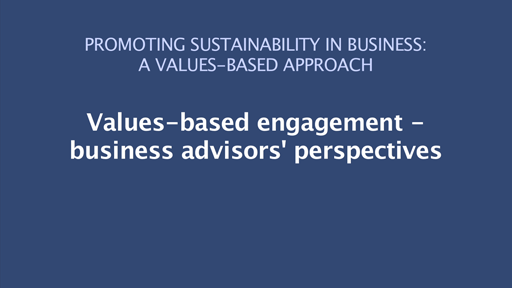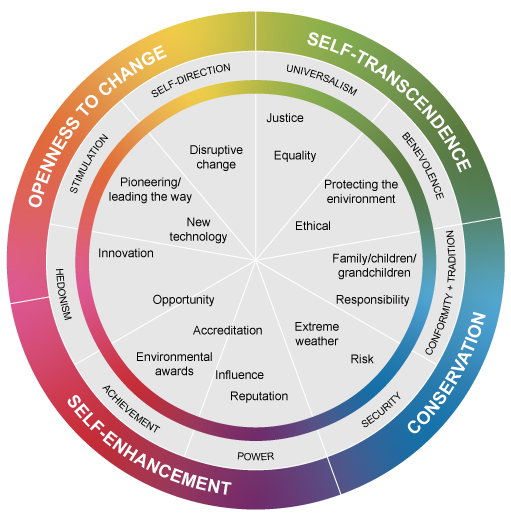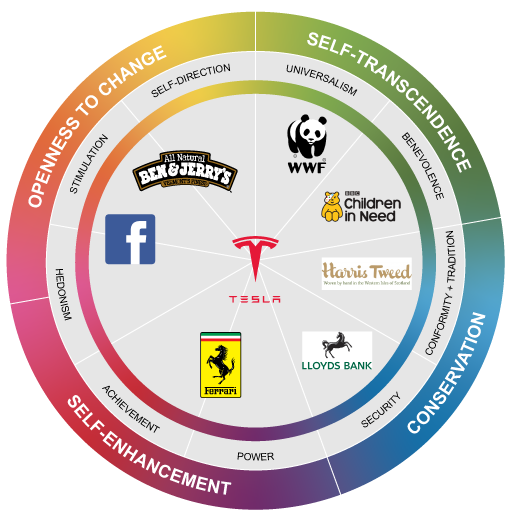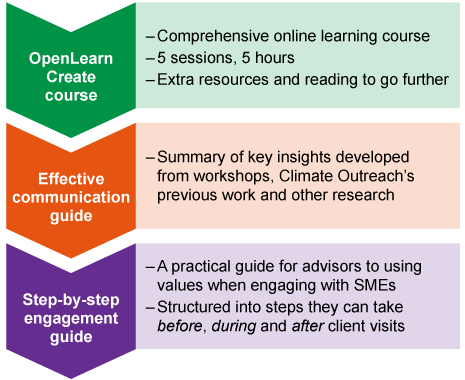Use 'Print preview' to check the number of pages and printer settings.
Print functionality varies between browsers.
Printable page generated Monday, 1 December 2025, 11:52 AM
4 A values-based approach to engagement (2/2): practice
4 A values-based approach to engagement (2/2): practice
So far in this course you have learned about the challenges faced by environmental professionals when trying to encourage SMEs to reduce their environmental impact; and about how values influence the ways that businesses and individuals approach this issue.
The remainder of the course focuses on the practicalities of using values with SMEs. We begin with a few practical illustrations.
Activity 4.1: Values-based engagement – a practitioner perspective
The aim of this activity is to consider how the values-based approach can be applied in practice. We begin by hearing from the practitioners you met in Activity 2.1, who discuss what they understand to be values-based approaches to engaging with SMEs.

Transcript
Values-based engagement – business advisors’ perspectives
[MUSIC PLAYING]
[What does the term ‘values-based engagement’ mean to you?]
Watch the video (around 3 and a half minutes) and consider the questions below. For each question, add a couple of sentences explaining your response.
4.1 Combining values and language
The next activity builds on the Schwartz Theory of Basic Human Values, which we introduced in Session 3 (Activity 3.2). It asks you to think about the way you communicate with business owners and managers, and how to use the most appropriate language for organisations and individuals with different sets of values.
Activity 4.2: Using the right language
Have a look at the words above and below the diagram. Each word relates to environmental sustainability and is likely to resonate with individuals and businesses who hold different values. Drag and drop each word onto the diagram, where you think they might fit best. Once you have completed this activity, you can compare your results with our researchers’ version.
Part two of this activity asks you to drag and drop a number of brand logos onto the Theory of Basic Human Values diagram. There are no ‘correct’ answers here, but it helps to remind us that some businesses present strong values as part of their brand image.
Comment
Here are our attempts at the two exercises – how do they compare with your versions?


Did you find it easy to choose where to put these brands? In some cases brand-values are very clear, whereas other companies can speak to different sets of values depending on context and audience. Tesla, for example, has clear ambitions for achieving a low-carbon transportation system, but at the same time its luxury cars might also be symbols of achievement and power for their customers.
4.2 The values-based toolkit
The final activity in this session introduces you to the values-based toolkit and how it relates to the course and other resources.
Activity 4.3: Introducing the values-based toolkit
The values-based toolkit is made up of three components. The first, overarching and comprehensive part is the OpenLearn Create course you are currently 4/5ths of the way through. Besides this, the toolkit consists of two additional resources.
Based on previous research, workshops and interviews with more than 50 low carbon advisors, the communication specialists Climate Outreach have produced a guide for communicating with SMEs using appropriate values-based language and images.
- Read the Effective communication guide and make your own notes. The guide can be viewed on screen or downloaded for viewing offline.
The final component of the toolkit is a practical ‘Step-by-step engagement guide’ for bringing values into engagements with SMEs – from preparing for a visit, to face-to-face meetings and following up afterwards to maximise long-term impact.
- Read the interactive Step-by-step engagement guide and make your own notes. An interactive version of the guide can be viewed on screen; it can also be downloaded for viewing offline.
We will be returning to the toolkit in Session 5, when you will have an opportunity to put it into practice by responding to a ‘real world’ scenario.
 Thinking point
Thinking point
Which topic(s) covered in the Effective communication guide or the Step-by-step engagement guide did you see as particularly relevant to your work? Did you find any of the ideas particularly surprising, controversial or unlikely to work based on your own experience?
Summary and action points
In this session we have described how values come into play in the workplace from a range of sources. We heard about how Climate Outreach use values to engage different segments of the public on the issue of climate change. They have identified particular messages that speak to the values held by faith groups or the centre-right.
We also introduced the Theory of Basic Human Values, based on work in social psychology.
You should now be able to:
- Reflect on the values that you encounter in your own workplace.
- Consider how organisational, professional and personal values can be variously aligned or in conflict
- Predict how attitudes towards environmental issues are likely to be influenced by different basic human values.
You have now completed Session 4.
